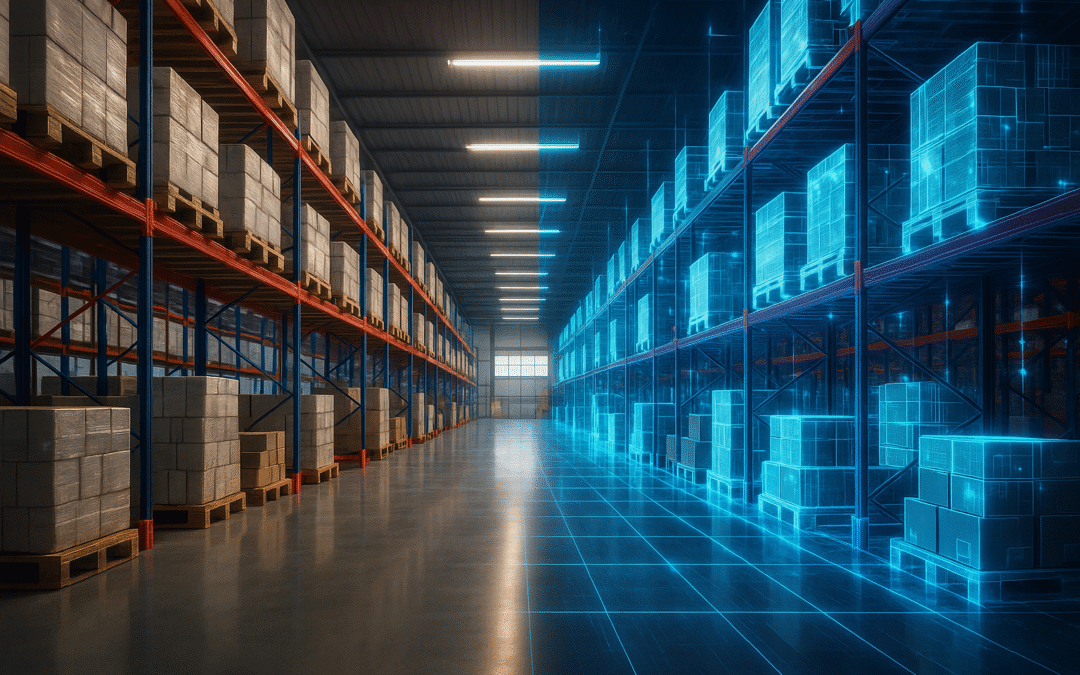~4 Minute Read
Introduction
Most operations can tell you what happened yesterday. Very few can tell you what’s happening right now – or what’s about to break tomorrow. That’s the gap digital twins are closing. They connect your systems, sensors, and processes into one live model that mirrors how your business actually runs – and predicts what’s next.
It’s not a concept anymore. The technology has quietly matured. AI, automation, and real-time data pipelines have finally made digital twins practical for everyday operators – not just large manufacturers or R&D labs. And the payoff is fast: better visibility, fewer surprises, and measurable ROI in months, not years.
What It Is
A digital twin is a live, data-driven mirror of your operation – from the production floor to the warehouse to the last mile. It connects ERP, WMS, IoT devices, PLCs, and APIs into a single view that updates continuously as work happens. With a digital twin, you can simulate changes before making them, test new layouts or automation plans virtually, and identify bottlenecks or downtime before they disrupt production.
It’s a simple idea with big implications: see everything, test anything, improve continuously. And while definitions of “digital twin” have varied for years, new ISO standards now make it clear: a digital twin’s purpose is simulation – not control. It’s not about driving valves or managing live systems; it’s about safely modeling, testing, and improving them. That clarity matters, because it helps teams focus their investment where simulation actually drives results – not where other tools like controllers, HMIs, or monitoring systems already do the job.
Who It’s For
Digital twins are built for operators who move product, manage assets, or coordinate people and processes. Whether you run plants, warehouses, or logistics networks, the value is the same: better decisions, faster response, and fewer surprises.
It applies equally to a manufacturer looking to predict downtime before it happens, a distributor wanting real-time visibility into inventory levels across branches to improve coordination and efficiency, or a feed operation modeling production and delivery to stay in sync with demand. The common denominator is complexity – and the need to see the whole picture.
Why It’s Finally Possible
Historically, digital twins required perfect data and fully integrated systems – which made them expensive, slow, and hard to maintain. Most were static models, accurate once and outdated a week later. Today, AI bridges those gaps.
Modern digital twins can ingest data that isn’t perfectly structured, interpret it in real time, and learn from new inputs. Cloud integration and IoT connectivity mean your ERP, production, and logistics systems can finally talk to each other without months of prep work.
The result is a twin that’s grounded in reality – living, learning, and improving alongside your operation. And perhaps most importantly, these solutions are surprisingly affordable today. What used to take enterprise budgets and long rollouts can now be deployed quickly and scaled over time, making digital twins accessible to mid-market operators for the first time.
What It Enables
When implemented correctly, a digital twin replaces guesswork with predictive insight. It helps teams:
- Visualize operations in real time – equipment status, inventory flow, workforce performance
- Run “what-if” scenarios – test disruptions, new layouts, or automation plans before committing
- Optimize inventory and scheduling – balance labor, throughput, and delivery performance
- Forecast demand and maintenance – predict bottlenecks and downtime before they hit
In recent projects, operators have achieved double-digit throughput gains, reduced labor waste, and faster onboarding of new facilities – all without touching live production.
How It’s Delivered
At Captios, we follow a Crawl – Walk – Run model to make digital twins practical for any operation:
- Crawl (Foundation): Build a validated model from historical data and establish baseline KPIs.
- Walk (Optimization): Simulate and remove bottlenecks, deploy live dashboards.
- Run (Continuous): Forecast disruptions, automate response, and enable AI-driven decisioning.
This approach ensures early wins – often within weeks – and measurable ROI that compounds over time.
The Payoff
Digital twins deliver visibility, speed, and ROI measured in months, not years. They let teams “test before they invest”, reducing risk on capital projects, improving throughput, and minimizing costly downtime. The end result: operations that are resilient, predictable, and ready to scale.
Closing
Captios delivers digital twin solutions built on proven simulation and AI technologies – enabling real-time visibility, scenario modeling, and continuous optimization.
If you’re curious where your biggest ROI opportunities might come from, let’s run a quick demo. We’ll show you what a digital twin could uncover in your operation – and where the low-hanging efficiency gains are hiding.
Reach out to us here or send me a note directly at pelsoci.michael@captiospartners.co.


Recent Comments